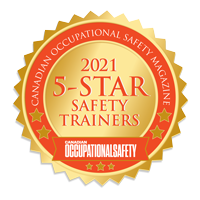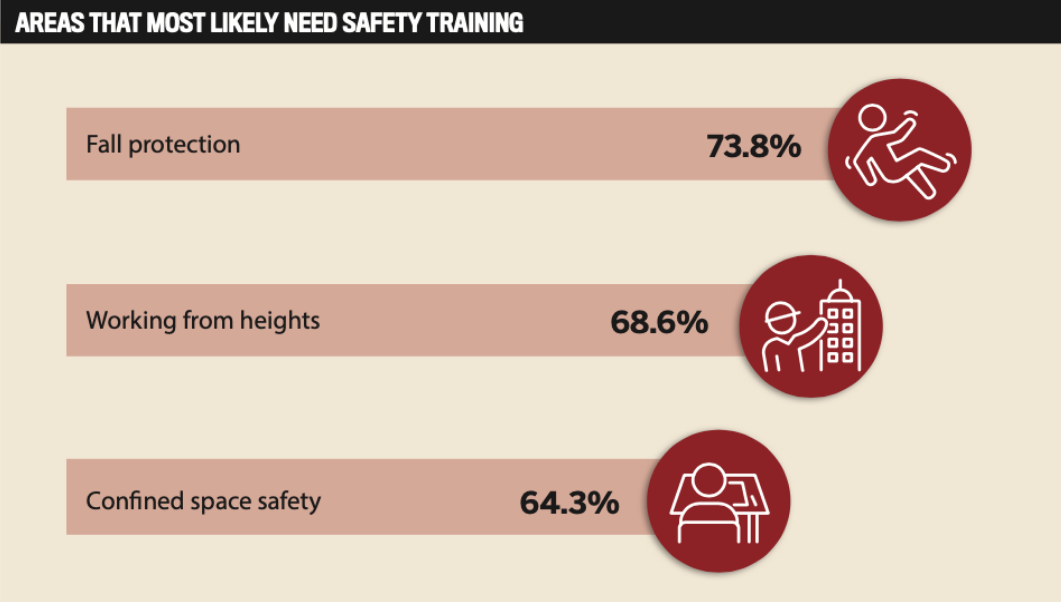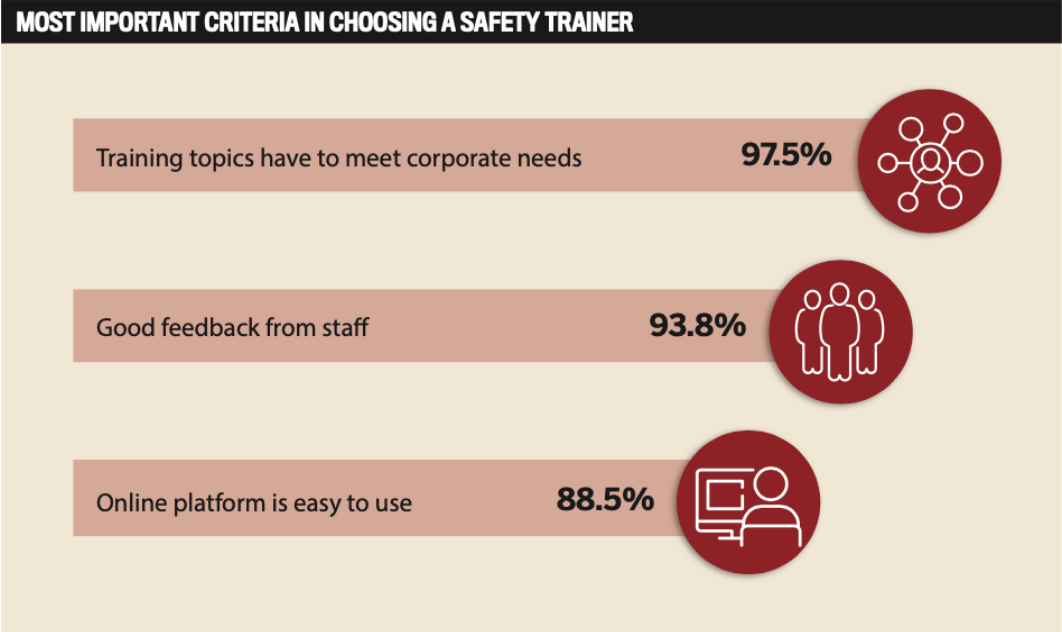

Jump to winners | Jump to methodology | View PDF
Since the outbreak of COVID-19, the pandemic has had a far-reaching effect on almost all aspects of workplace health and safety. From offices shutting down to worksites implementing rigorous hygiene measures, the last year has disrupted how health and safety are defined in the workplace.
One area that hasn’t received as much press is safety training although safety training and educating on health and safety are essential. In handling OHS issues, knowledge is key and, in many cases, a requirement. Traditionally, training has been dispensed in classrooms with in-person instruction and testing. Training takes many forms, whether short modules or long certificates, and is a necessity in almost all industries.

Digital shift
With social distancing de rigueur, classroom teaching went out the window. And even if recovery seems to be around the corner in many Canadian provinces, the shift toward digital may be permanent for some – or may become a robust option.
“Continuous improvement is our business model, and there have been many challenges this pandemic year to balance the needs of our clients as well as providing high-quality training,” says James Donato of Workplace Law Consulting.
Nevertheless, trainers such as Cameron Hacault of Haland Learning highlight that uncertainty around the COVID-19 protocol remains a huge issue that will likely continue into post-pandemic recovery. This is a sentiment shared by many safety professionals.
“It was challenging to deliver training online, when this was new for all of us, the trainers and participants. Workers were at home with children, pets and many responsibilities,” says Louise Caicco Tett of Health & Safety Professionals.
And while many companies found luck moving to the digital space, making that transition was no small feat. Trainers needed to be flexible to switch from in-person learning to live online training.
“I’m thankful to have worked with Tanya Steele and Paula Gagne at WIO Educates to help me get set up to deliver live online learning at a high level,” says Hacault.
In addition to professional advantages, there have also been personal benefits to transitioning to a digital or hybrid model.
“We all rose to the challenge and found ways to share our knowledge, learn and interact. In some ways, it was more personal as we got to say hello to curious children and learn a little more about what was important to one another,” says Caicco Tett.

A difficult transition
Another issue facing safety trainers is that due to COVID-19 restrictions around their work, many of them took a steep financial hit.
“Entrepreneurs like myself have also faced income inconsistency issues. On March 11 last year, my income went to $0 immediately, and the next few months were horrible for our family,” says Hacault.
This is a problem echoed by other safety professionals as well.
“COVID put a damper on in-person training, which reduced revenue overall. Once procedures and protocol were put in place, we were able to demonstrate a very safe atmosphere [where] our clients could send their employees to,” says Andrea Crittenden of Sixteen Safety Services.
Despite the initial problems, training in various forms ultimately was forced to continue due to workplace requirements.
“Regardless of the pandemic, essential and allowable business had to continue, and that doesn’t exempt anyone from not receiving or providing training. Employees still require and deserve the same level and standard of training that we previously delivered, and we were able to pull through for them,” says Crittenden.
Indeed, one of the benefits of shifting to digital is that trainers can now reach a wider audience than ever before. For those not able to attend in-person sessions, accessing online courses is a plus – the shift to digital has made health and safety more accessible than ever before.
What the experts say
Training requirements depend not only on each specific workplace but also on provincial health and safety regulations, which can vary depending on location. Although the pandemic has thrown a spanner in the works, the shift to digital platforms has been largely successful.
Many trainers are looking to a hybrid model post-pandemic, which would include both online training and classroom sessions.
COVID-19 may have been a financial blow for many companies, but the pandemic has shown to employers the importance of keeping up to date with health and safety training.
Changing pace
Although the shift to digital for safety training may have been forced by the pandemic, trainers were not the only ones impacted by the move online.
With social distancing guidelines and the constant threat of workplace outbreaks, where possible, many employers in Canada asked their employees to work from home at the start of the pandemic. Over a year on, some businesses and organizations are looking to make the shift permanent – or at least aiming to integrate more flexibility.
The workplace environment is starting to shift, and health and safety concerns may look slightly different as well. Safety training is in constant flux because it needs to keep up with current concerns, as demonstrated by the pandemic.
In addition, although safety training is a requirement in many environments, the pandemic showed that numerous businesses and organizations simply weren’t up to scratch, whether in emergency planning or training. Many companies were caught short at the start of the pandemic.
Plagued with COVID-19 outbreaks and financial losses, employers are now taking health and safety more seriously and investing more than ever before in safety training. While many training organizations took a serious hit at the start of the pandemic, the demand for adequate training seems likely to accelerate in the future.
Market recognition
Since its inception almost 60 years ago, COS has proudly showcased top companies making a difference. Supporting the best in class means that our readers can always ensure that they are working with top companies.
“As we expand our market, these awards support our efforts, and we thank Canadian Occupational Safety for the recognition,” says Caicco Tett.
“It is an honour and a privilege to win this award after many years of hard work serving our valued and loyal clients,” says Donato. “Thank you, Canadian Occupational Safety, for recognizing our amazing team, as people are an employer’s most important asset!”
For many of these organizations, these awards confirm what they already know: “It means that our business model is working, and our customers become repeat customers who [receive] a genuine return on investment for training their employees. We want everyone receiving a high standard and quality of training so they return home to their loved ones each night,” says Crittenden.
Despite such a tough year, the 5-Star Award winners have doubled down on their efforts to ensure that safety training is as good as ever.
“I really focus 100% of my energy on continually trying to improve how I design and deliver training,” says Hacault. “Getting this award is a pleasant surprise. I recognize it, I appreciate it, and now I’ll get back to my work.”
Health and safety consultant, Public Services Health & Safety
Regional consultant, workplace health and safety, Public Services Health & Safety
Health and safety consultant, Public Services Health & Safety
Over the last few months, Canadian Occupational Safety researchers have interviewed and surveyed thousands of safety professionals across Canada to find out who they recognise as Canada’s top safety trainers.
Participants rated safety trainers across a range of criteria, asking them to assign numerical scores to the companies’ performance. A shortlist was created based on the collated results of thousands of votes from safety professionals across the country. In addition to surveys, in-depth interviews were conducted with safety professionals in Canadian companies and other safety specialists.
Based on the importance of each criteria, an algorithm was applied to determine the star rating for safety trainers. The top-ranking trainers were awarded 5-star ratings. Where companies rated highly enough to achieve an 80% or higher approval rating, they were awarded a 5-star rating in the relevant criterion or area.
To determine the ratings, COS analysts gave a weighting to each criterion, depending on its relative importance for customers. For example, if customer service was ranked as the most important criterion for customers, then customer service was weighted more heavily than other criteria such as meeting requirements. The COS analysts applied an algorithm to the data to reflect the weighting and importance of each criterion, ultimately coming up with a winners’ list consisting of 16 individuals and 23 organizations.
